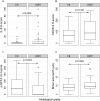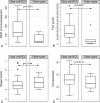The role of CXC-chemokine receptor CXCR2 and suppressor of cytokine signaling-3 (SOCS-3) in renal cell carcinoma
- PMID: 24593195
- PMCID: PMC4015755
- DOI: 10.1186/1471-2407-14-149
The role of CXC-chemokine receptor CXCR2 and suppressor of cytokine signaling-3 (SOCS-3) in renal cell carcinoma
Abstract
Background: Chemokine receptor signaling pathways are implicated in the pathobiology of renal cell carcinoma (RCC). However, the clinical relevance of CXCR2 receptor, mediating the effects of all angiogenic chemokines, remains unclear. SOCS (suppressor of cytokine signaling)-3 is a negative regulator of cytokine-driven responses, contributing to interferon-α resistance commonly used to treat advanced RCC with limited information regarding its expression in RCC.
Methods: In this study, CXCR2 and SOCS-3 were immunohistochemically investigated in 118 RCC cases in relation to interleukin (IL)-6 and (IL)-8, their downstream transducer phosphorylated (p-)STAT-3, and VEGF expression, being further correlated with microvascular characteristics, clinicopathological features and survival. In 30 cases relationships with hypoxia-inducible factors, i.e. HIF-1a, p53 and NF-κΒ (p65/RelA) were also examined. Validation of immunohistochemistry and further investigation of downstream transducers, p-JAK2 and p-c-Jun were evaluated by Western immunoblotting in 5 cases.
Results: Both CXCR2 and IL-8 were expressed by the neoplastic cells their levels being interrelated. CXCR2 strongly correlated with the levels of HIF-1a, p53 and p65/RelA in the neoplastic cells. Although SOCS-3 was simultaneously expressed with p-STAT-3, its levels tended to show an inverse relationship with p-JAK-2 and p-c-Jun in Western blots and were positively correlated with HIF-1a, p53 and p65/p65/RelA expression. Neither CXCR2 nor SOCS-3 correlated with the extent of microvascular network. IL-8 and CXCR2 expression was associated with high grade, advanced stage and the presence/number of metastases but only CXCR2 adversely affected survival in univariate analysis. Elevated SOCS-3 expression was associated with progression, the presence/number of metastasis and shortened survival in both univariate and multivariate analysis.
Conclusions: Our findings implicate SOCS-3 overexpression in RCC metastasis and biologic aggressiveness advocating its therapeutic targeting. IL-8/CXCR2 signaling also contributes to the metastatic phenotype of RCC cells but appears of lesser prognostic utility. Both CXCR2 and SOCS-3 appear to be related to transcription factors induced under hypoxia.
Figures









Similar articles
-
Expression of interleukin-8 receptor CXCR2 and suppressor of cytokine signaling-3 in astrocytic tumors.Mol Med. 2012 May 9;18(1):379-88. doi: 10.2119/molmed.2011.00449. Mol Med. 2012. PMID: 22231733 Free PMC article.
-
Immunohistochemical analysis of IL-6, IL-8/CXCR2 axis, Tyr p-STAT-3, and SOCS-3 in lymph nodes from patients with chronic lymphocytic leukemia: correlation between microvascular characteristics and prognostic significance.Biomed Res Int. 2014;2014:251479. doi: 10.1155/2014/251479. Epub 2014 May 5. Biomed Res Int. 2014. PMID: 24883303 Free PMC article.
-
Galectin-3 promotes CXCR2 to augment the stem-like property of renal cell carcinoma.J Cell Mol Med. 2018 Dec;22(12):5909-5918. doi: 10.1111/jcmm.13860. Epub 2018 Sep 24. J Cell Mol Med. 2018. PMID: 30246456 Free PMC article.
-
Interleukin-6 induces drug resistance in renal cell carcinoma.Fukushima J Med Sci. 2018 Dec 8;64(3):103-110. doi: 10.5387/fms.2018-15. Epub 2018 Oct 23. Fukushima J Med Sci. 2018. PMID: 30369518 Free PMC article. Review.
-
Jak/STAT/SOCS signaling circuits and associated cytokine-mediated inflammation and hypertrophy in the heart.Shock. 2006 Sep;26(3):226-34. doi: 10.1097/01.shk.0000226341.32786.b9. Shock. 2006. PMID: 16912647 Review.
Cited by
-
The role and gene expression profile of SOCS3 in colorectal carcinoma.Oncotarget. 2017 Dec 20;9(22):15984-15996. doi: 10.18632/oncotarget.23477. eCollection 2018 Mar 23. Oncotarget. 2017. PMID: 29662621 Free PMC article.
-
CXCR2 Activated JAK3/STAT3 Signaling Pathway Exacerbating Hepatotoxicity Associated with Tacrolimus.Drug Des Devel Ther. 2024 Dec 28;18:6331-6344. doi: 10.2147/DDDT.S496195. eCollection 2024. Drug Des Devel Ther. 2024. PMID: 39749191 Free PMC article.
-
The role of chemoattractant receptors in shaping the tumor microenvironment.Biomed Res Int. 2014;2014:751392. doi: 10.1155/2014/751392. Epub 2014 Jul 10. Biomed Res Int. 2014. PMID: 25110692 Free PMC article. Review.
-
Identification of the Prognostic Value Among Suppressor Of Cytokine Signaling Family Members in Kidney Renal Clear Cell Carcinoma.Front Mol Biosci. 2021 Dec 2;8:585000. doi: 10.3389/fmolb.2021.585000. eCollection 2021. Front Mol Biosci. 2021. PMID: 34926570 Free PMC article.
-
Transcriptional repression of SOCS3 mediated by IL-6/STAT3 signaling via DNMT1 promotes pancreatic cancer growth and metastasis.J Exp Clin Cancer Res. 2016 Feb 4;35:27. doi: 10.1186/s13046-016-0301-7. J Exp Clin Cancer Res. 2016. Retraction in: J Exp Clin Cancer Res. 2023 Jan 12;42(1):18. doi: 10.1186/s13046-023-02595-3. PMID: 26847351 Free PMC article. Retracted.
References
-
- Slaton JW, Inoue K, Perrotte P, El-Naggar AK, Swanson DA, Fidler IJ, Dinney CP. Expression levels of genes that regulate metastasis and angiogenesis correlate with advanced pathological stage of renal cell carcinoma. Am J Pathol. 2001;158:735–743. doi: 10.1016/S0002-9440(10)64016-3. - DOI - PMC - PubMed
-
- Carmeliet P, Dor Y, Herbert JM, Fukumura D, Brusselmans K, Dewerchin M, Neeman M, Bono F, Abramovitch R, Maxwell P, Koch CJ, Ratcliffe P, Moons L, Jain RK, Collen D, Keshert E. Role of HIF-1α in hypoxia-mediated apoptosis, cell proliferation and tumour angiogenesis. Nature. 1998;394(998):485–490. - PubMed
MeSH terms
Substances
LinkOut - more resources
Full Text Sources
Other Literature Sources
Medical
Research Materials
Miscellaneous

